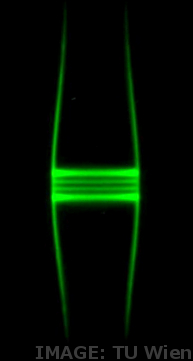Photon finding for solar boost
 Australian scientists are laying the groundwork for a serious solar panel efficiency boost.
Australian scientists are laying the groundwork for a serious solar panel efficiency boost.
The vast majority of photovoltaic solar panels in use today are made from silicon. While these panels are relatively inexpensive and widely available, they are approaching their fundamental efficiency limits.
The highest efficiency currently achieved by silicon solar cells stands at 27.3 per cent, with an absolute theoretical limit of 29.4 per cent.
“Today’s solar cells work by absorbing photons, which are then channelled to the electrodes to generate electricity,” says Professor Tim Schmidt from UNSW's School of Chemistry.
“But as part of this process, a lot of this light is lost as heat, which is why solar panels don’t run at full efficiency.”
To get to the next level of efficiency, researchers have been looking at ‘singlet fission’ - splitting a single photon into two lower-energy particles.
This could allow solar cells to harness more of the sun's energy, reducing the amount lost as heat and improving overall efficiency.
A new study details a significant breakthrough in understanding how photons can be split, using magnetic fields for the first time to reveal new details.
By applying magnetic fields, the researchers were able to slow down the singlet fission process - focusing on how one photon can be split into two - making it easier to observe and understand.
“The magnetic fields manipulate the wavelengths of emitted light to reveal the way that singlet fission occurs. And that hasn't been done before,” Professor Schmidt said.
Integrating singlet fission could allow for a paradigm shift in solar technology, where silicon cells could reach efficiency levels above 30 per cent. The researchers have proposed adding a molecular layer to the solar cell that can split photons into smaller energy packets, effectively increasing the amount of usable energy.
Last year, the Australian Renewable Energy Agency (ARENA) selected the UNSW singlet fission project as part of its Ultra Low Cost Solar program.
This initiative aims to develop solar technologies capable of exceeding 30 per cent efficiency at a cost of less than 30 cents per watt by 2030.
The team is now working on creating a prototype of an improved silicon solar cell and plans to collaborate with industry partners to bring this technology to market.
“We’re confident we can get silicon solar cells to an efficiency above 30 per cent,” Professor Schmidt says.
The team’s latest study is accessible here.








 Print
Print